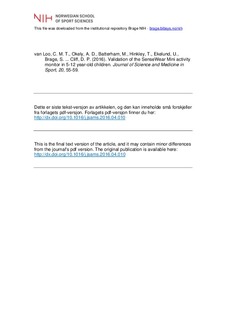| dc.contributor.author | van Loo, Christiana M. T. | |
| dc.contributor.author | Okely, Anthony D. | |
| dc.contributor.author | Batterham, Marijka | |
| dc.contributor.author | Hinkley, Trina | |
| dc.contributor.author | Ekelund, Ulf | |
| dc.contributor.author | Brage, Søren | |
| dc.contributor.author | Reilly, John J. | |
| dc.contributor.author | Peoples, Gregory E. | |
| dc.contributor.author | Jones, Rachel A. | |
| dc.contributor.author | Janssen, Xanne | |
| dc.contributor.author | Cliff, Dylan P. | |
| dc.date.accessioned | 2018-11-06T09:48:53Z | |
| dc.date.available | 2018-11-06T09:48:53Z | |
| dc.date.created | 2017-02-03T11:32:31Z | |
| dc.date.issued | 2017 | |
| dc.identifier.citation | Journal of Science and Medicine in Sport. 2017, 20, 55-59. | nb_NO |
| dc.identifier.issn | 1440-2440 | |
| dc.identifier.uri | http://hdl.handle.net/11250/2571196 | |
| dc.description | I Brage finner du siste tekst-versjon av artikkelen, og den kan inneholde ubetydelige forskjeller fra forlagets pdf-versjon. Forlagets pdf-versjon finner du på sciencedirect.com / In Brage you'll find the final text version of the article, and it may contain insignificant differences from the journal's pdf version. The definitive version is available at sciencedirect.com | nb_NO |
| dc.description.abstract | Objectives: This study aimed to validate SenseWear Mini software algorithm versions 2.2 (SW2.2) and 5.2 (SW5.2) for estimating energy expenditure (EE) in children. Design: Laboratory-based validation study. Methods: 57 children aged 5−12 y completed a protocol involving 15 semi-structured sedentary (SED), light-intensity (LPA), and moderate- to vigorous-intensity (MVPA) physical activities. EE was estimated using portable indirect calorimetry (IC). The accuracy of EE estimates (kcal·min−1) from SW2.2 and SW5.2 were examined at the group level and individual level using the mean absolute percentage error (MAPE), Bland-Altman plots and equivalence testing. Results: MAPE values were lower for SW5.2 (30.1 ± 10.7%) than for SW2.2 (44.0 ± 6.2%). Although mean differences for SW5.2 were smaller than for SW2.2 during SED (−0.23 ± 0.22 vs. −0.61 ± 0.20 kcal·min−1), LPA (−0.69 ± 0.76 vs. −1.07 ± 0.46 kcal·min−1) and MVPA (−2.22 ± 1.15 vs. −2.57 ± 1.15 kcal·min−1), limits of agreement did not decrease for the updated algorithms. For all activities, SW2.2 and SW5.2 were not equivalent to IC (p > 0.05). Errors increased with increasing intensity. Conclusion: The current SenseWear Mini algorithms SW5.2 underestimated EE. The overall improved accuracy for SW5.2 was not accompanied with improved accuracy at the individual level and EE estimates were not equivalent to IC. | nb_NO |
| dc.language.iso | eng | nb_NO |
| dc.subject | energy expenditure | nb_NO |
| dc.subject | physical activity | nb_NO |
| dc.subject | accelerometry | nb_NO |
| dc.subject | calorimetry | nb_NO |
| dc.subject | validation study | nb_NO |
| dc.title | Validation of the SenseWear Mini activity monitor in 5−12-year-old children | nb_NO |
| dc.title.alternative | Validation of the SenseWear Mini activity monitor in 5−12-year-old children | nb_NO |
| dc.type | Journal article | nb_NO |
| dc.type | Peer reviewed | nb_NO |
| dc.description.version | acceptedVersion | nb_NO |
| dc.source.pagenumber | 55-59 | nb_NO |
| dc.source.volume | 20 | nb_NO |
| dc.source.journal | Journal of Science and Medicine in Sport | nb_NO |
| dc.source.issue | 1 | nb_NO |
| dc.identifier.doi | 10.1016/j.jsams.2016.04.010 | |
| dc.identifier.cristin | 1446569 | |
| dc.description.localcode | Seksjon for idrettsmedisinske fag / Department of Sports Medicine | nb_NO |
| cristin.unitcode | 150,34,0,0 | |
| cristin.unitname | Seksjon for idrettsmedisinske fag | |
| cristin.ispublished | true | |
| cristin.fulltext | postprint | |
| cristin.qualitycode | 1 | |
